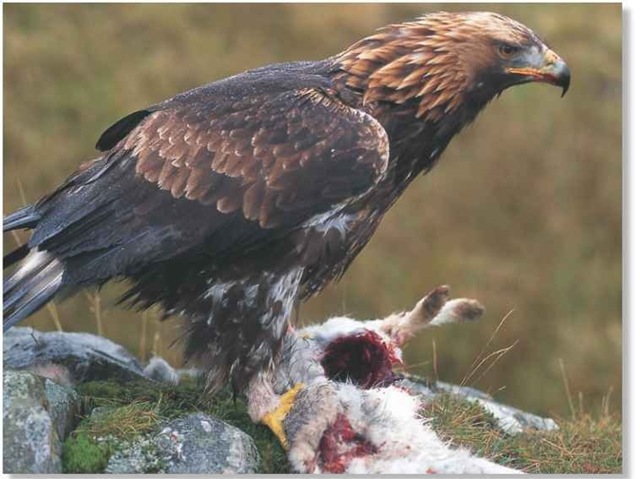ORDER
Falconiformes
FAMILY
Accipitridae
GENUS & SPECIES
KEY FEATURES
• Able to soar effortlessly for long periods on its broad, 6.5′-long wings
• Ranges across territories as large as 80 sq. miles: an area similar to that of a medium-sized city
• Traditional nests, or eyries, may be used by generation after generation of golden eagles
WHERE IN THE WORLD?
Inhabits the western and northern U.S. and eastern Canada, parts of Europe, east through much of central and northern Asia; also parts of Africa
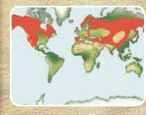
LIFECYCLE
A regal resident of the “roof of the world,” the golden eagle naturally symbolizes power and majesty as it soars, swoops and strikes with graceful, yet deadly, effect.
Habitat
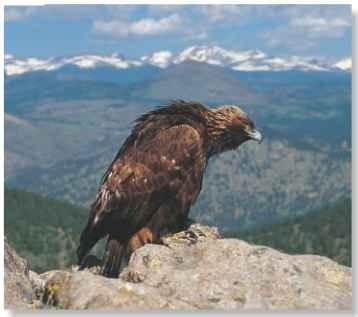
A Eagle eyed
The golden eagle surveys its domain from a perch.
The golden eagle, popularly called the “king of the birds,” is the most widespread eagle of the Northern Hemisphere,
favoring open, often mountainous, habitats. It avoids densely wooded areas, typically found just above the treeline, but below the level of permanent snow. It shuns heavily populated and farmed areas, perhaps as a result of past declines in numbers caused by human persecution and poisoning by agricultural chemicals.
In flat landscapes, such as green grassland and prairie regions, without cliffs to perch and scan for prey, the golden eagle uses rocky outcrops and hilltops to watch for its prey.
# The world population of golden eagles is estimated at 125,000-250,000 birds.
# The feathers of the golden eagle weigh more than its entire skeleton.
Breeding
Within a territory a pair of eagles may have up to a dozen nest sites, called eyries, on cliff ledges or in old, tall trees. Each spring, the pair selects one eyrie and renovates it with fresh twigs. Egg-laying takes place from January in the south of the species’ range and from May in the most northerly regions.
The female incubates her first egg immediately and lays a second egg 2-5 days later: The male takes only occasional shifts on the nest. When the first chick hatches in six weeks, the male brings food to the nest, which the female tears into morsels for the chick.
By the time the second egg hatches, the first chick is growing rapidly. When food is scarce, the second chick may be attacked and killed by the older chick. This ensures that at least one chick receives enough food to survive.
FEATHERING THE NEST
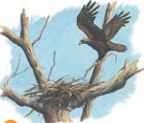
A nest…
A fork in the boughs of a large, tall tree is a favorite nest site. Both birds build the nest, which can measure 3′ across.
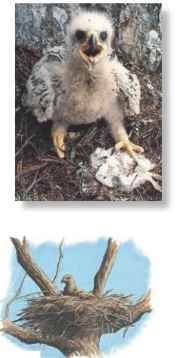
that grows…
Over the years, a pair may establish several eyrie sites, but often return to a favorite one, adding fresh twigs and bracken.
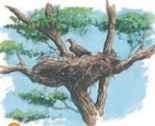
and grows…
Later generations may continue to use their ancestors’ eyries; some nests continue to be favored and grow ever bigger.
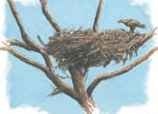
to be huge!
After decades of being added to, an eyrie may become a sprawling platform over 6.5′ deep and contain masses of material.
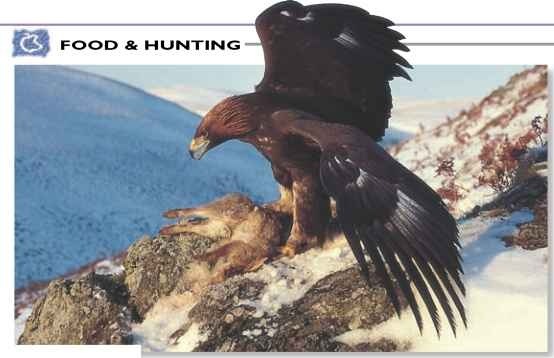
A The eagle has landed
The golden eagle devours its prey on the spot. If it has young to feed, it carries the prey back to the nest.
The eagle’s diet varies widely across its range. Typical prey are small to medium-sized mammals and birds, such as rabbits, hares, ground squirrels, marmots, young deer, grouse, partridges and pheasants. Prey is spotted by the eagle as it flies over, quartering the terrain.Then, in a high-speed glide, it drops and grabs its victim in its talons. Gamebirds, though, may be snatched in midair
A pair of eagles sometimes hunt together, with one bird flushing out prey and the other swooping in to kill. Small prey is crushed by its talons; the sharp claw on each hindtoe pierces the victim’s body to kill it swiftly. It then tears its catch apart on the spot. In winter the eagle also feeds on carrion.
Behavior
Male and female eagles mate for life; once a pair has established a home territory, it stays there from year to year However, eagles in the far north are migratory, flying to warmer lowlands farther south to avoid the winter Although there are a few records of birds actively fighting over disputed territories, the golden eagle has often been observed making undulating display flights near the boundaries of its territory, which may help warn off other eagles.
In late winter, pairs are often seen soaring and swooping in another form of undulating display, called “sky-dancing.” This is I a mating, rather than territorial, ritual. During this display, the I female may roll onto her back in flight, presenting her talons to the male as he swoops above her Mating takes place on the ground, but is often followed by further sky-dancing.
Young eagles are driven
Young blood This juvenile golden eagle has yet to acquire the more uniform, golden brown plumage of an adult bird.
out of their parents’ territory about four months after fledging and become nomadic until they’re old enough to breed at 4-5 years; some young birds travel up to 1,200 miles.

CONSERVATION
In the past, the golden eagle was persecuted in many parts of its range, mainly by farmers who believed that it killed lambs and by gamekeepers seeking to protect gamebird stocks. More recently, agricultural pesticides and pollution ingested through prey have resulted in the eagles laying eggs with such thin shells that they break in the nest before hatching. Today, stricter laws protect the eagle and though it isn’t threatened overall, it’s becoming increasingly rare.
PROFILE
Golden Eagle
Flying high over great tracts of wilderness, the golden eagle uses its superkeen eyesight to scan the ground below for signs of potential prey.

Creature comparisons
All eagles have broad wings with “fingered” tips, but there are many variations on wing shape. The crowned eagle (Spizaetus coronatus), which flies over dense forests of central Africa, has short, rounded wings to maneuver in tight spaces between the trees.The long, wide wings the martial eagle (Polemaetus bellicosus) — the largest African eagle — are designed for long periods on the wing. When hunting, martial eagles glide high over open grasslands and deserts in search of large birds, hares and even antelopes.

Martial eagle
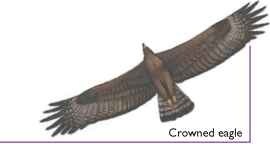
| VITAL | |
| STATISTICS | |
| Weight | Male 6.511 lbs.; female 9-15 lbs. |
| Length I Head/Body Tail | 2.5-3′ 10-14″ |
| Wingspan | 6.5-7′ |
| Sexual [Maturity | 4-5 years |
| Breeding Season | February-July |
| Number of Eggs | Usually 2, but rarely 1 or 3 |
| Incubation Period | 42-45 days |
| Fledging Period | 65-70 days |
| Breeding 1 Interval | 1 year |
| Typical Diet | Mammals, birds, lizards, carrion |
| Lifespan | Up to 25 years |
RELATED SPECIES
• There are eight eagle species in the Aquila genus, including the lesser spotted eagle (Aquila pomarina) of central Europe and Asia, which has a wingspan of about 5′. Verreaux’s eagle (Aquila verreauxii) of central and southern Africa has a 7.5′ wingspan. The Spanish race of the imperial eagle (Aquila heliaca) is one of the rarest of all eagles, with only about 60 pairs remaining in the wild.
